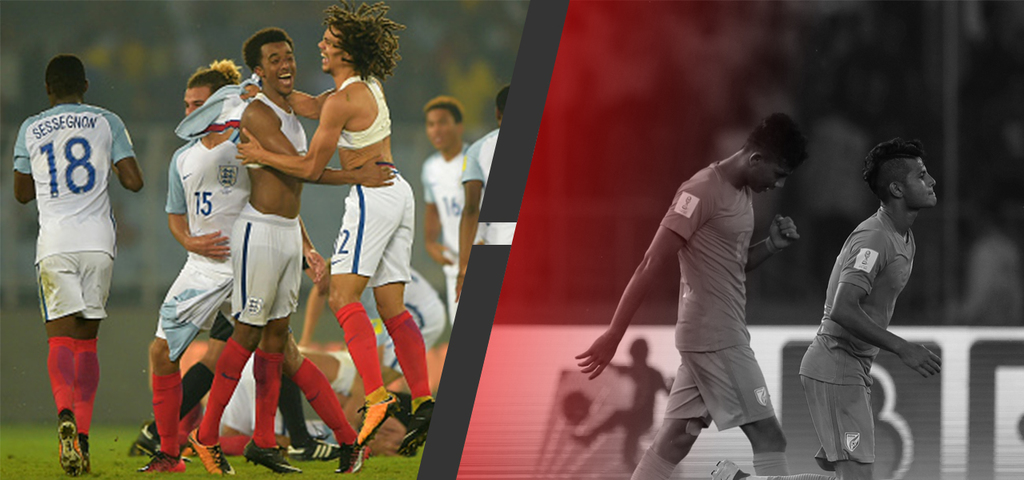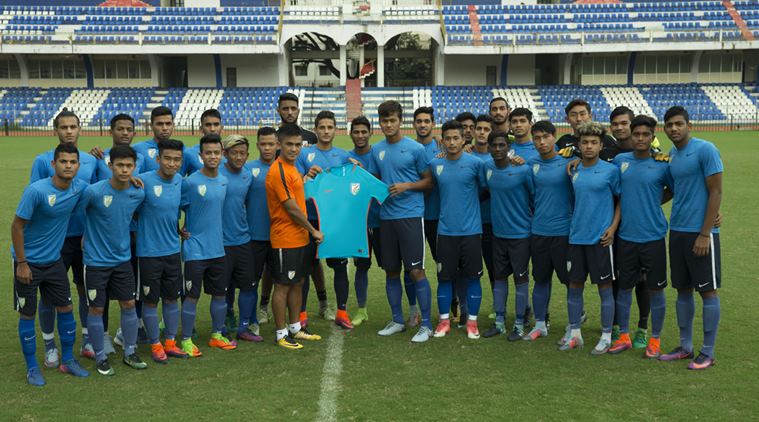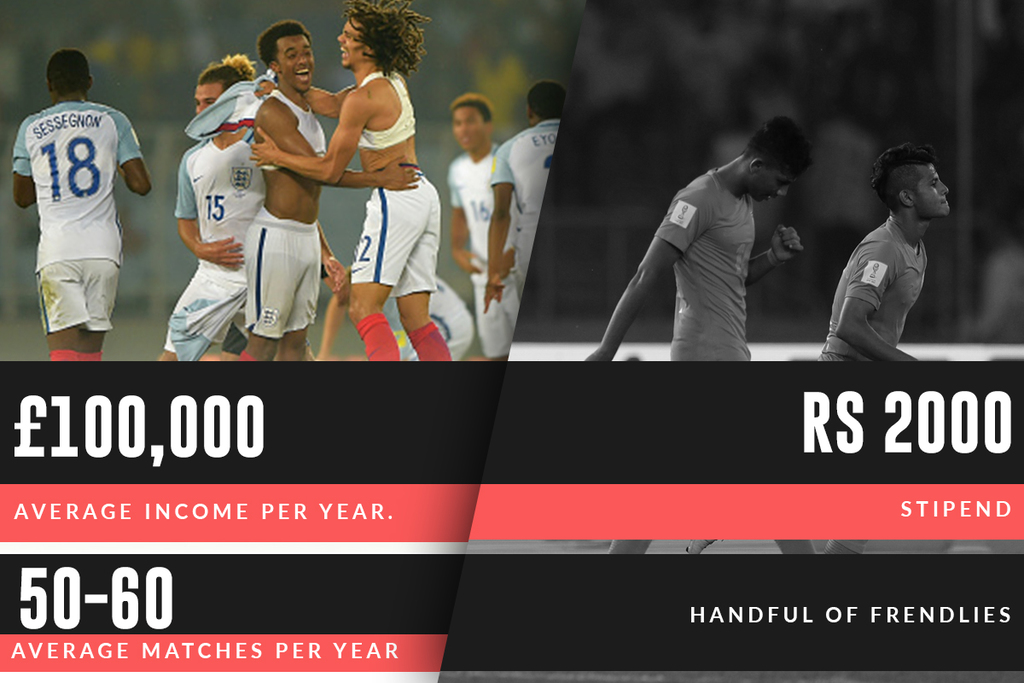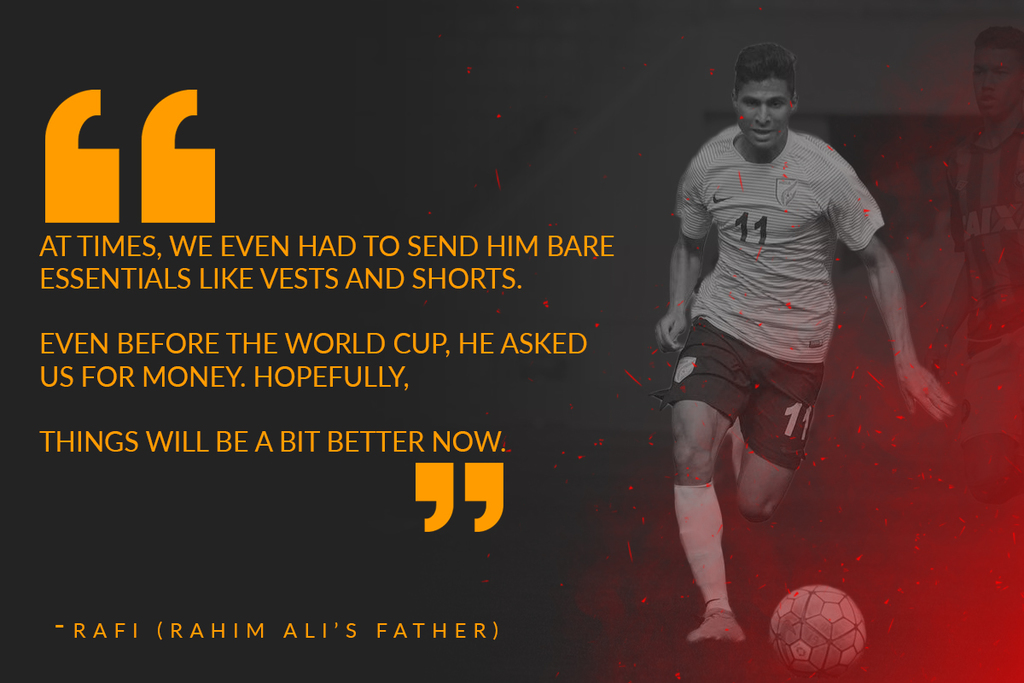Begin typing your search above and press return to search.
Featured
The Lions Roar: How big is the gap between India and England?

Jubilant scenes might not have dawned upon the masses residing in India when the country won the rights to host the FIFA U17 World Cup on December 2013, but cue four years later and the Salt Lake Stadium in Kolkata was the venue for an all mighty bash as the final was held against England and Spain. India might be known more for its international cricket team but in recent years, the national football team has been doing its bit to rise in stature, exposure and quality thanks to stalwarts like Sunil Chhetri and Gurpreet Singh Sandhu, who became the first Indian to play in a top flight European league with Norway's Stabaek. The advent of the Indian Super League played its part in the inaugural season as the likes of Alessandro Del Piero (Juventus) and Luis Garcia (Liverpool) won hearts and led many to believe that football will finally become the sport that everyone wants to be part of. This was the first time a league featured international standard players from Europe, even though most of them didn't have the same quality as they had a few years ago.  The love for the game continued to grow and that was more than evident during the U17 World Cup across six cities where the country broke the record for most attendants with 1.3 million fanatics lapping up every minute of the action. There was another reason for the excitement generated from the event, not only was India hosting an international football event, this would also be the first time an Indian team would have played in a FIFA World Cup.
The love for the game continued to grow and that was more than evident during the U17 World Cup across six cities where the country broke the record for most attendants with 1.3 million fanatics lapping up every minute of the action. There was another reason for the excitement generated from the event, not only was India hosting an international football event, this would also be the first time an Indian team would have played in a FIFA World Cup. 
 One such example pointed out from the report was that of Rahim Ali, who did play in the tournament, is that his father often has to send money and clothes to his son, despite him being selected for the youth national side. What is more concerning is the fact that the parent is only a rickshaw puller and that in itself does not ensure a bright future for the family. Sacrifice is the only way forward for Rahim's family. "At times, we even had to send him bare essentials like vests and shorts. Even before the World Cup, he asked us for money. Hopefully, things will be a bit better now. But I am not expecting a massive change in our fortunes. Instead, I am planning to bear all his expenses so that he can have a bright future," Rafi (Rahim's father) told the Times of India.
One such example pointed out from the report was that of Rahim Ali, who did play in the tournament, is that his father often has to send money and clothes to his son, despite him being selected for the youth national side. What is more concerning is the fact that the parent is only a rickshaw puller and that in itself does not ensure a bright future for the family. Sacrifice is the only way forward for Rahim's family. "At times, we even had to send him bare essentials like vests and shorts. Even before the World Cup, he asked us for money. Hopefully, things will be a bit better now. But I am not expecting a massive change in our fortunes. Instead, I am planning to bear all his expenses so that he can have a bright future," Rafi (Rahim's father) told the Times of India.  The other major problem with the Indian football scene is that youth players only get to play a handful of competitive matches in a year while it is reported that a quality European player gets a chance to impress in around 50-60 matches in a year.
The other major problem with the Indian football scene is that youth players only get to play a handful of competitive matches in a year while it is reported that a quality European player gets a chance to impress in around 50-60 matches in a year.  Even if we are not looking at the European teams, the youth structures in other Asian power houses are getting better. If we are to look at one example, Manchester City have a sister club in the Australian A League and Major League Soccer. Indian clubs have tried their hand at the same with Pune City FC collaborating with ACF Fiorentina and Atletico de Kolkata trying up with the La Liga side Atletico Madrid. The Pune side also has a number of youth teams spread across the various divisions in the Indian game, they even feature a women's side, which just goes to show that the club does want to make a mark in the Indian game, so the wheels are in motion for a few sides but the I-League clubs still need to work on their structures.
Even if we are not looking at the European teams, the youth structures in other Asian power houses are getting better. If we are to look at one example, Manchester City have a sister club in the Australian A League and Major League Soccer. Indian clubs have tried their hand at the same with Pune City FC collaborating with ACF Fiorentina and Atletico de Kolkata trying up with the La Liga side Atletico Madrid. The Pune side also has a number of youth teams spread across the various divisions in the Indian game, they even feature a women's side, which just goes to show that the club does want to make a mark in the Indian game, so the wheels are in motion for a few sides but the I-League clubs still need to work on their structures.
 The love for the game continued to grow and that was more than evident during the U17 World Cup across six cities where the country broke the record for most attendants with 1.3 million fanatics lapping up every minute of the action. There was another reason for the excitement generated from the event, not only was India hosting an international football event, this would also be the first time an Indian team would have played in a FIFA World Cup.
The love for the game continued to grow and that was more than evident during the U17 World Cup across six cities where the country broke the record for most attendants with 1.3 million fanatics lapping up every minute of the action. There was another reason for the excitement generated from the event, not only was India hosting an international football event, this would also be the first time an Indian team would have played in a FIFA World Cup. Two tales of youthful exuberance
If there were two teams to keep an eye on during the competition, for different reasons, they were the Indian and English side. The host nation were playing in their first ever FIFA World Cup and the pressure on the shoulders of the youngster was always going to be immense. England, on the other hand, were expected to do really well in the competition as the U20 side had just picked up their World Cup a month or so ago and this side had lost in the European Championships, with many predicting this was the team to beat. While India didn't win a single game, the home side won the hearts of millions thanks to their energetic performances, and truth be told, the side could have picked up a couple of points from their matches. On the other side of the draw, England were at their best as they won all their group games and even after a tough penalty shoot-out win over Japan in the knockout round, the Three Lions swept away the United States, Brazil and Spain to lift the tournament for the very first time. There were a number of heroes for the English side such as Rhian Brewster, Phil Foden and Jadon Sancho. Brewster ended the tournament as the top scorer and that doesn't really tell the entire story of how well the youngsters of the English team have progressed compared to the other sides. Brewster has been knocking on the door of the Liverpool first team and his fast-track growth has seen the 17-year- old play for the U23 Liverpool side. Sancho, in pursuit of making it big and getting quality playing time under his belt left Premier League powerhouse Manchester City in the summer for Germany's Borussia Dortmund, where he even made his debut a week or so ago. The Dortmund man had a deal with the English side as he left the team after the group stages and did not take part in the knockout round but that just goes to show how far the English players will go to ensure they turn out to be the best, if not, at least reach their potential. Things however, are not that easy or rosy for the Indian side. Although the players wore their heart on the sleeves, there still is a major gap when it comes to not only the quality of players the Indian side comes up with but also regarding how they are developed from the grassroots level.A tough beginning with no guarantee of success
The top English talents might not all be starring for big named Premier League clubs as of yet, however, even playing in the lower English leagues does provide them not only an opportunity to play against quality players from other countries but also to make a decent enough living. Sancho moving to a Bundesliga side such as Borussia Dortmund, which are possibly the best supported side in the country, would easily be making over A?100,000 in a year. In fact, most of the English players have a safety net in the lower leagues being very well funded. Even if a player cannot make it to the top leagues, playing in the lower leagues can also lead to not only great competition but also is a very decent career opportunity. That sort of money can never be expected from an Indian player, even possibly if he does make it to the national team.For footballers the rewards for putting in hours of effort does not really bear fruit unless they are at the top of their game. In a recent report from the Times of India, each player from the U17 side actually gets a meagre monthly stipend of INR 2000 a month, which really does not take you far. The players also receive INR 15,000-17,000 for exposure tours but that is never going to be enough to make a positive impact on the economic health of the player or the family.Football in Europe and even South America has always been a popular sport for the masses to get involved in, in India, as we all know, cricket is the sport of choice and even if a player does not make it to the national side, playing in the Ranji Trophy games can lead to a decent enough life.

 One such example pointed out from the report was that of Rahim Ali, who did play in the tournament, is that his father often has to send money and clothes to his son, despite him being selected for the youth national side. What is more concerning is the fact that the parent is only a rickshaw puller and that in itself does not ensure a bright future for the family. Sacrifice is the only way forward for Rahim's family. "At times, we even had to send him bare essentials like vests and shorts. Even before the World Cup, he asked us for money. Hopefully, things will be a bit better now. But I am not expecting a massive change in our fortunes. Instead, I am planning to bear all his expenses so that he can have a bright future," Rafi (Rahim's father) told the Times of India.
One such example pointed out from the report was that of Rahim Ali, who did play in the tournament, is that his father often has to send money and clothes to his son, despite him being selected for the youth national side. What is more concerning is the fact that the parent is only a rickshaw puller and that in itself does not ensure a bright future for the family. Sacrifice is the only way forward for Rahim's family. "At times, we even had to send him bare essentials like vests and shorts. Even before the World Cup, he asked us for money. Hopefully, things will be a bit better now. But I am not expecting a massive change in our fortunes. Instead, I am planning to bear all his expenses so that he can have a bright future," Rafi (Rahim's father) told the Times of India. What is being done for our youngsters?
The AIFF vice-president Subrata Datta claimed that the body has provided food and lodgings to the players and will also give them a chance of playing in the I-League. That is one way forward but the ISL is the more lucrative option with mega bucks coming in not only from sponsors but from the owners of the clubs which often include film stars such as Ranbir Kapoor and even has Sachin Tendulkar gracing a number of matches for the Kerala Blasters. Playing in the ISL would certainly give them exposure to international coaches, Marco Materazzi is a World Cup winner and was the manager of Chennaiyin FC and some of our players would have picked up a lot from the Italian defender. The AIFF does know that it has a lot of work to do to ensure the Indian players get the right exposure to facilitate their growth. Youth academies all around the world have scouts and keep tabs on players when they are around 7-8 years old and start their development. The other major problem with the Indian football scene is that youth players only get to play a handful of competitive matches in a year while it is reported that a quality European player gets a chance to impress in around 50-60 matches in a year.
The other major problem with the Indian football scene is that youth players only get to play a handful of competitive matches in a year while it is reported that a quality European player gets a chance to impress in around 50-60 matches in a year.  Even if we are not looking at the European teams, the youth structures in other Asian power houses are getting better. If we are to look at one example, Manchester City have a sister club in the Australian A League and Major League Soccer. Indian clubs have tried their hand at the same with Pune City FC collaborating with ACF Fiorentina and Atletico de Kolkata trying up with the La Liga side Atletico Madrid. The Pune side also has a number of youth teams spread across the various divisions in the Indian game, they even feature a women's side, which just goes to show that the club does want to make a mark in the Indian game, so the wheels are in motion for a few sides but the I-League clubs still need to work on their structures.
Even if we are not looking at the European teams, the youth structures in other Asian power houses are getting better. If we are to look at one example, Manchester City have a sister club in the Australian A League and Major League Soccer. Indian clubs have tried their hand at the same with Pune City FC collaborating with ACF Fiorentina and Atletico de Kolkata trying up with the La Liga side Atletico Madrid. The Pune side also has a number of youth teams spread across the various divisions in the Indian game, they even feature a women's side, which just goes to show that the club does want to make a mark in the Indian game, so the wheels are in motion for a few sides but the I-League clubs still need to work on their structures. The journey has just begun for us
Even with a lot of work left to do, the U17 World Cup can be deemed a success. The Indian side might have lost all their matches but their passion and commitment in every game cannot be questioned.There were reports that scouts from a number of clubs were keeping an eye on the Indian players and if a few of them can be snapped up, even for a few years, it will make an immense difference to their playing style and quality. Rome wasn't built in a day, and it seems that we are on the right track to ensure that our footballers, at least this generation, achieves something more than just playing in a World Cup. Long term planning has to be a key requirement at the moment because losing out on the momentum from this World Cup is something none of us can afford to do. A quality base will and can make all the difference and there is no better time than now to invest in grassroots football. Come on India, let's football!Thousands of fans cheered them on while they played their hearts our while millions skipped cricket matches and other events to keep a track of the young guns looking to make it out.
Next Story






